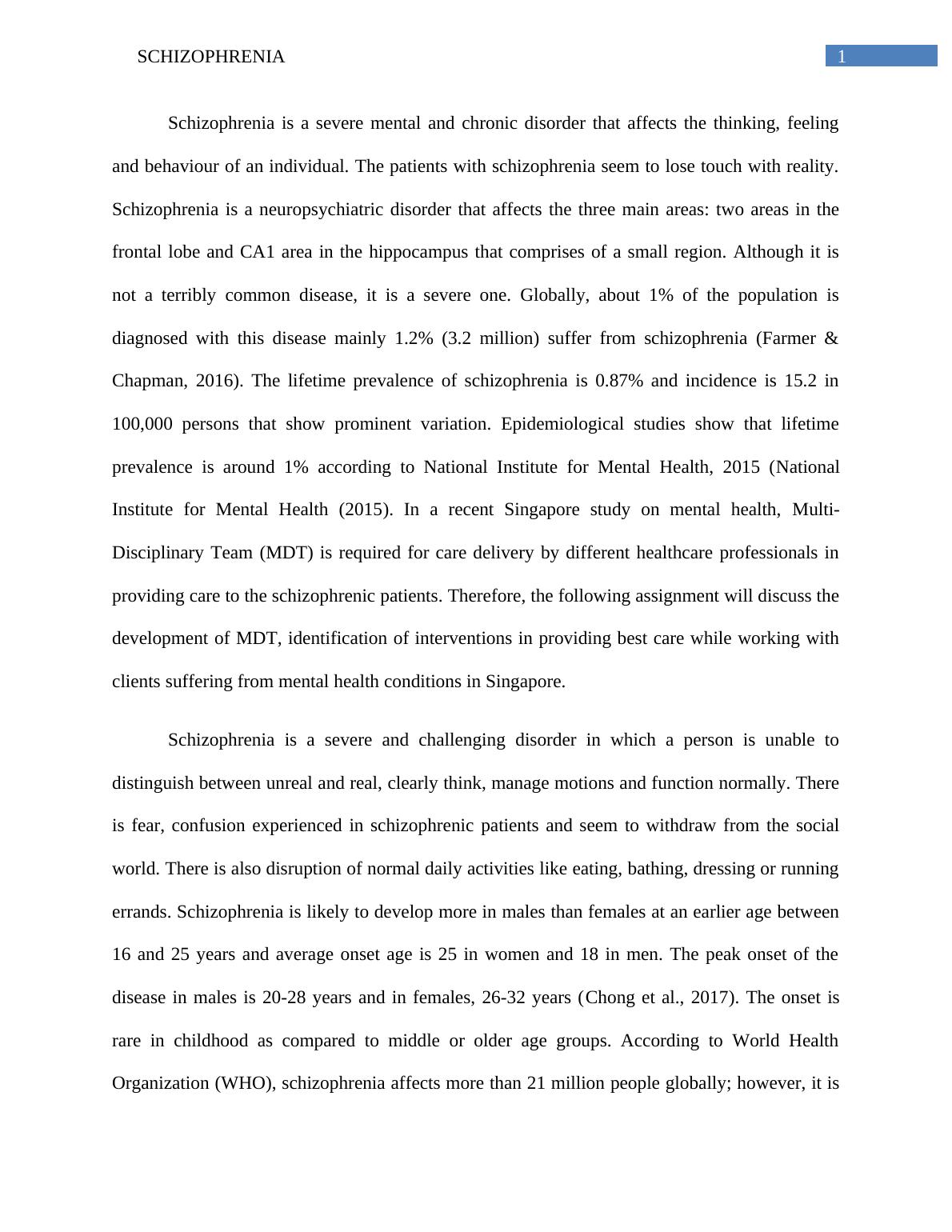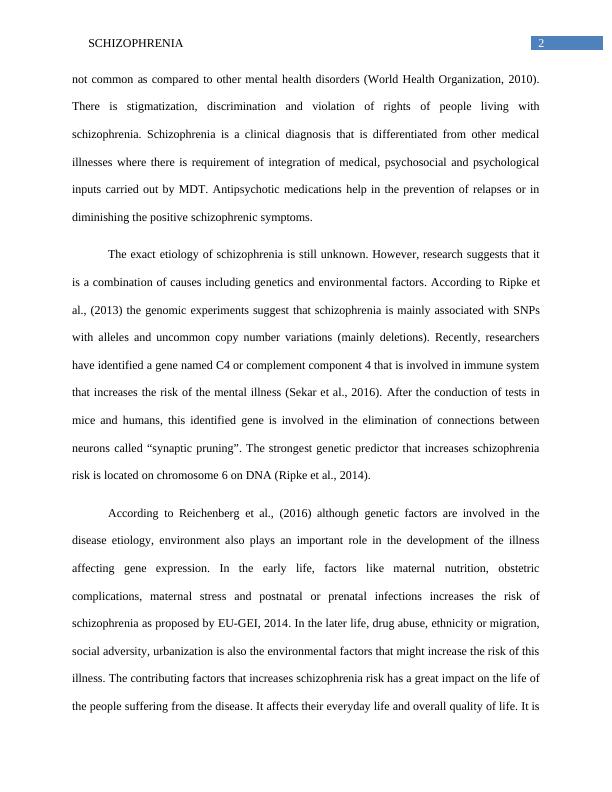Schizophrenia: An Overview
14 Pages3544 Words101 Views
Added on 2020-05-11
Schizophrenia: An Overview
Added on 2020-05-11
ShareRelated Documents
Running head: SCHIZOPHRENIASchizophreniaName of the StudentName of the UniversityAuthor note

1SCHIZOPHRENIASchizophrenia is a severe mental and chronic disorder that affects the thinking, feelingand behaviour of an individual. The patients with schizophrenia seem to lose touch with reality.Schizophrenia is a neuropsychiatric disorder that affects the three main areas: two areas in thefrontal lobe and CA1 area in the hippocampus that comprises of a small region. Although it isnot a terribly common disease, it is a severe one. Globally, about 1% of the population isdiagnosed with this disease mainly 1.2% (3.2 million) suffer from schizophrenia (Farmer &Chapman, 2016). The lifetime prevalence of schizophrenia is 0.87% and incidence is 15.2 in100,000 persons that show prominent variation. Epidemiological studies show that lifetimeprevalence is around 1% according to National Institute for Mental Health, 2015 (NationalInstitute for Mental Health (2015). In a recent Singapore study on mental health, Multi-Disciplinary Team (MDT) is required for care delivery by different healthcare professionals inproviding care to the schizophrenic patients. Therefore, the following assignment will discuss thedevelopment of MDT, identification of interventions in providing best care while working withclients suffering from mental health conditions in Singapore. Schizophrenia is a severe and challenging disorder in which a person is unable todistinguish between unreal and real, clearly think, manage motions and function normally. Thereis fear, confusion experienced in schizophrenic patients and seem to withdraw from the socialworld. There is also disruption of normal daily activities like eating, bathing, dressing or runningerrands. Schizophrenia is likely to develop more in males than females at an earlier age between16 and 25 years and average onset age is 25 in women and 18 in men. The peak onset of thedisease in males is 20-28 years and in females, 26-32 years (Chong et al., 2017). The onset israre in childhood as compared to middle or older age groups. According to World HealthOrganization (WHO), schizophrenia affects more than 21 million people globally; however, it is

2SCHIZOPHRENIAnot common as compared to other mental health disorders (World Health Organization, 2010).There is stigmatization, discrimination and violation of rights of people living withschizophrenia. Schizophrenia is a clinical diagnosis that is differentiated from other medicalillnesses where there is requirement of integration of medical, psychosocial and psychologicalinputs carried out by MDT. Antipsychotic medications help in the prevention of relapses or indiminishing the positive schizophrenic symptoms. The exact etiology of schizophrenia is still unknown. However, research suggests that itis a combination of causes including genetics and environmental factors. According to Ripke etal., (2013) the genomic experiments suggest that schizophrenia is mainly associated with SNPswith alleles and uncommon copy number variations (mainly deletions). Recently, researchershave identified a gene named C4 or complement component 4 that is involved in immune systemthat increases the risk of the mental illness (Sekar et al., 2016). After the conduction of tests inmice and humans, this identified gene is involved in the elimination of connections betweenneurons called “synaptic pruning”. The strongest genetic predictor that increases schizophreniarisk is located on chromosome 6 on DNA (Ripke et al., 2014). According to Reichenberg et al., (2016) although genetic factors are involved in thedisease etiology, environment also plays an important role in the development of the illnessaffecting gene expression. In the early life, factors like maternal nutrition, obstetriccomplications, maternal stress and postnatal or prenatal infections increases the risk ofschizophrenia as proposed by EU-GEI, 2014. In the later life, drug abuse, ethnicity or migration,social adversity, urbanization is also the environmental factors that might increase the risk of thisillness. The contributing factors that increases schizophrenia risk has a great impact on the life ofthe people suffering from the disease. It affects their everyday life and overall quality of life. It is

3SCHIZOPHRENIAtroublesome to life alteration that affects personal, professional and social life. There is tendencyof the individuals to withdraw themselves from others and exhibit mood behaviors that areinappropriate making relationships difficult. Symptoms associated with the disease like delusionsor hallucinations hinder them from participating their family chores and social life. There is alsoreduced physical performance due to worsening of physical health exacerbating Activities ofDaily Living (ADL) disability (Patel et al., 2014). The resultant impairments are witnessedacross ADL from basic activities to mobility and job skills. Concisely, schizophrenia has apotential impact on the motor abilities, cognition and physical capacity hampering overall qualityof life. Schizophrenia is a complex disorder that involves the multiple pathways dysregulationwhere dopaminergic, GABAergic and glutamatergic neurotransmitter are affected. Anatomic,immune system and neurotransmitter abnormalities have implications on the schizophreniapathophysiology. There is identification of deficits in the acetylcholine muscarinic receptorswhere inflammation has been found to be the major contributor to the development, exacerbationof schizophrenia. Neuroimaging studies shows that there is decrease in brain volume, enlarged ventricles inthe medial temporal areas along with changes witnessed in hippocampus. Anatomicabnormalities are seen in the limbic and neocortical regions and in the interconnection of white-matter tracts that are reduced in the brains of schizophrenic patients. There are abnormalitiesseen in the dopaminergic systems exhibiting hypodopaminergic activity in mesocortical systemthat leads to negative symptoms and hyperdopaminergic activity that lead to positive symptoms(Jenkins, 2013). There is also over activation and disturbance in the immune system that mayresult in inflammatory cytokines over expression and alteration in function and structure of brain.

End of preview
Want to access all the pages? Upload your documents or become a member.
Related Documents
NURBN Psychotic Illness and Schizophrenia Assessment 2022lg...
|14
|2744
|17
Mental Illness and Bioinformatics Assignmentlg...
|8
|1856
|289
Case Study on Schizophrenia and Asymptomatic Antipsychoticslg...
|18
|5114
|226
Mental Health and Schizophrenia in Criminal Justicelg...
|7
|1490
|358
Somatic Symptom Disorder and Schizophrenialg...
|4
|783
|260
Annotated Bibliography on Schizophrenia Spectrum and Depressive Disorderslg...
|9
|2023
|349
